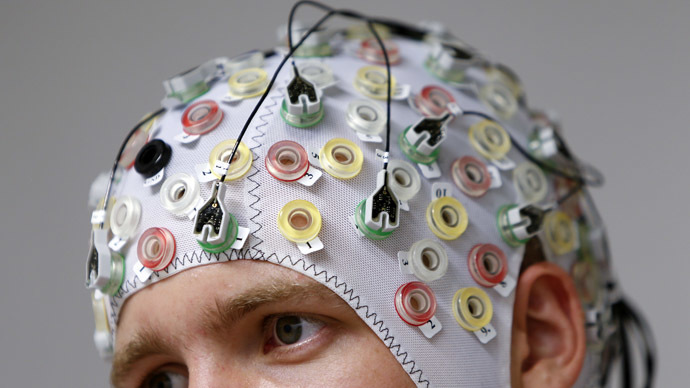Scientists use web-powered telepathy to link human thoughts (VIDEO)

Brain signals transmitted via the internet from one person to another have enabled two people to play a computer game by telepathy – with only one person seeing it and controlling the other’s hand movements in an experiment by US researchers.
In a paper titled “A direct brain-to-brain interface in humans,” recently published in Plos One journal, University of Washington (UW) scientists have revealed an intriguing test of brainpower to remotely control the actions of another person.
Three pairs of students participated in the experiment that started in August 2013, funded in part by the US Army Research Office. Each pair had their duties divided, with one participant deciding which moves the other should make in a computer game, firing a cannon at various points to defend a coastal city from pirates.
The other participant was sitting in a completely dark room in another building on campus, about a half mile away, and his only mission was to carry out the commands he received – that is, to hit the touchpad to fire the cannon without seeing the game itself.
“The new study brings our brain-to-brain interfacing paradigm from an initial demonstration to something that is closer to a deliverable technology,” co-author Andrea Stocco, a UW researcher, said in a statement. “Now we have replicated our methods and know that they can work reliably with walk-in participants.”
The signals during a real-time experiment were sent over the internet, and the time lag was only a fraction of a second. The success of the game varied among the pairs, from 25 to 83 percent. Scientists explained the misses with a sender’s failure to “accurately execute the thought to send the ‘fire’ command.”

The research team used an electroencephalography machine that reads brain activity to control the path of the game. The brain signals, transmitted via the internet, were received by a transcranial magnetic stimulation coil placed near the part of the brain that controls hand movements.
With a $1 million grant for the project, the scientists are planning to develop their telepathy experiments – in particular, to attempt to transmit more complex brain processes, such as concepts, thoughts and rules.
"What really characterizes humans is how much we rely on communication," co-author Stocco told Medical Daily. "And the ultimate limitation in communication is that not all of our thoughts can be easily put into words."

Another implication of the study is a future possibility to educate – so-called “brain tutoring” – when information is passed from a teacher to a student directly, without verbal communication.
“Imagine someone who’s a brilliant scientist but not a brilliant teacher. Complex knowledge is hard to explain – we’re limited by language,” said another co-author, Chantel Prat, a UW assistant professor of psychology.
Telepathy, a seemingly magical ability, has long fascinated and frustrated scientists, but it wasn’t until recently that the first real progress in the field was achieved. This September, an international team of scientists managed to send a signal from two people in India and France located 5,000 miles apart. On that occasion, the communication came in the simple form of the greetings, "Hola" and "Ciao."














